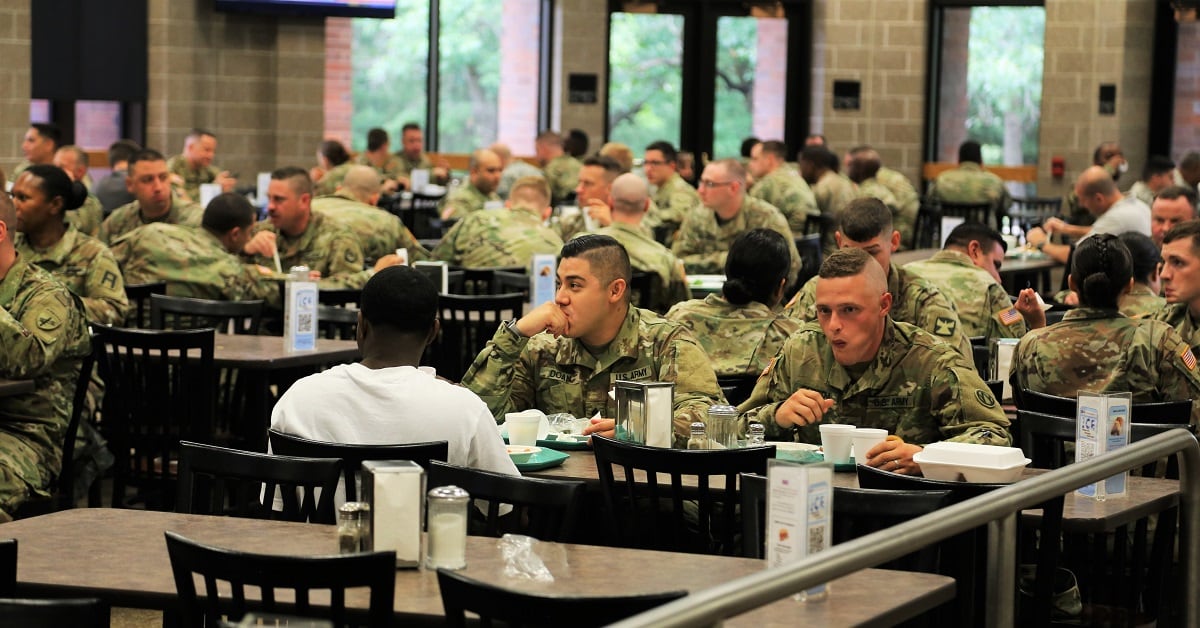Some soldiers in quarantine are opting to order delivery from nearby restaurants rather than eat the rations provided to them from government stockpiles.
At FOB Westbrook, a training site turned quarantine facility outside Fort Bliss, Texas, soldiers have been ordering food from establishments like Smash Burger, local pizzerias and even eating extra MREs rather than the “steam bathed” rations contracted for them.
Disliking chow hall food is a common trope of military life. But when new contracts for food services are meted out while soldiers continue to buy their own food, it treads into a larger issue of potentially wasteful spending that has been highlighted by lawmakers recently.
On average, soldiers already forgo using half their meal entitlements each month — wasting hundreds of millions of dollars each year — because of the distance to dining facilities and the quality of food offered, lawmakers said during a March 11 congressional hearing. In the case of quarantine sites, the issue appears to be food quality, and soldiers are once again finding other ways to eat.
“The food here was making everyone sick,” said a soldier who was at the quarantine site near El Paso. “Now that we stopped eating it we just order Smash Burger or eat MREs and snacks from AAFES.”
That soldier said he spent about $20 per day ordering food, though he receives a $5 per day incidental expense rate from the Army. His squad mostly stopped eating the chow provided to them.
Unitized group rations, which are heated by hot water immersion, are delivered by DynCorp International. That company has a $37 million contract to provide services for Fort Bliss quarantine sites, as well as other contracts for quarantines at Fort Bragg, Fort Lee and Fort Benning. Their services also include setting up showers, laundry operations and wifi connections.
But DynCorp doesn’t actually make the food at FOB Westbrook, according to those familiar with the contract. Its personnel simply draw rations from government stockpiles and deliver them to the quarantine site. Post spokespeople said soldiers can instead use an ordering service from AAFES, and “have been using their delivery system daily for more than a month.”
RELATED

Unitized group rations are delivered to the edge of the camp and soldiers in quarantine pick it up and serve it themselves. Those rations are served in the morning and evening. For lunch, soldiers are given MREs. Other quarantine sites at different installations reportedly serve hot meals as part of a different type of contract with DynCorp.
Quarantine in general is not too bad, a soldier said. The low-quality food and simply being kept away from families were the main complaints expressed.
“It could be better but it could also be a million times worse,” they added. “The food, though, is the worst food I have ever been served by the Army. Its borderline inedible. ... Even when it looks good, looks can fool.”
Soldiers are held in quarantine for two-week stays. At FOB Westbrook, they’re divided into about 38-person groups per large tent with cots that are spaced about six feet apart, one troop said. None of the people in their tent have become ill with COVID-19.
The soldier added that they think the sites are effective at stopping the spread of COVID-19 across the force, but not so great at preventing infection within quarantine camps.
RELATED

“They are trying,” the individual added. “I think the whole world was behind the curve on this and the Army is no exception.”
Fort Bliss places all service members returning from outside of a 100-mile radius of El Paso into quarantine sites where they’re evaluated by medics for symptoms throughout the day, post officials said. If a soldier tests positive for COVID-19, they’re placed into isolation. Pentagon guidance no longer allows individual bases to report their number of COVID-19 cases to the public.
Soldiers at FOB Westbrook are allowed to leave their tent areas and run. They’re also allowed to utilize a “gym-in-a-box” and pull-up bars. Though there is wifi, that tends to have a poor signal.
Some soldiers being quarantined are returning from deployments overseas, while others are returning from domestic assignments. Fort Bliss serves as the largest mobilization platform in the Defense Department, according to the Army, increasing the risk of infection if those rotating through are not properly screened.
“A lot of people come in at night so its hard to tell from where I am how many exactly are showing up,” the soldier who was at FOB Westbrook said.
Kyle Rempfer was an editor and reporter who has covered combat operations, criminal cases, foreign military assistance and training accidents. Before entering journalism, Kyle served in U.S. Air Force Special Tactics and deployed in 2014 to Paktika Province, Afghanistan, and Baghdad, Iraq.





